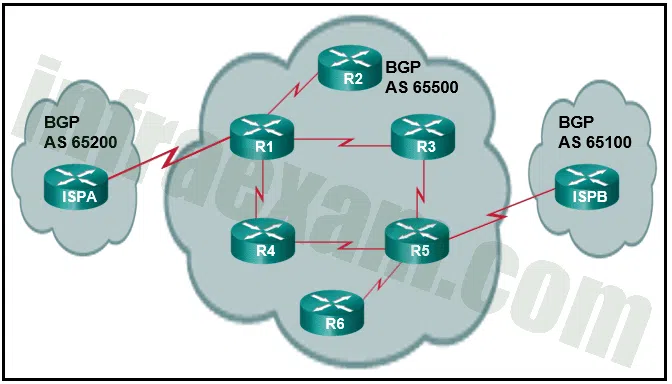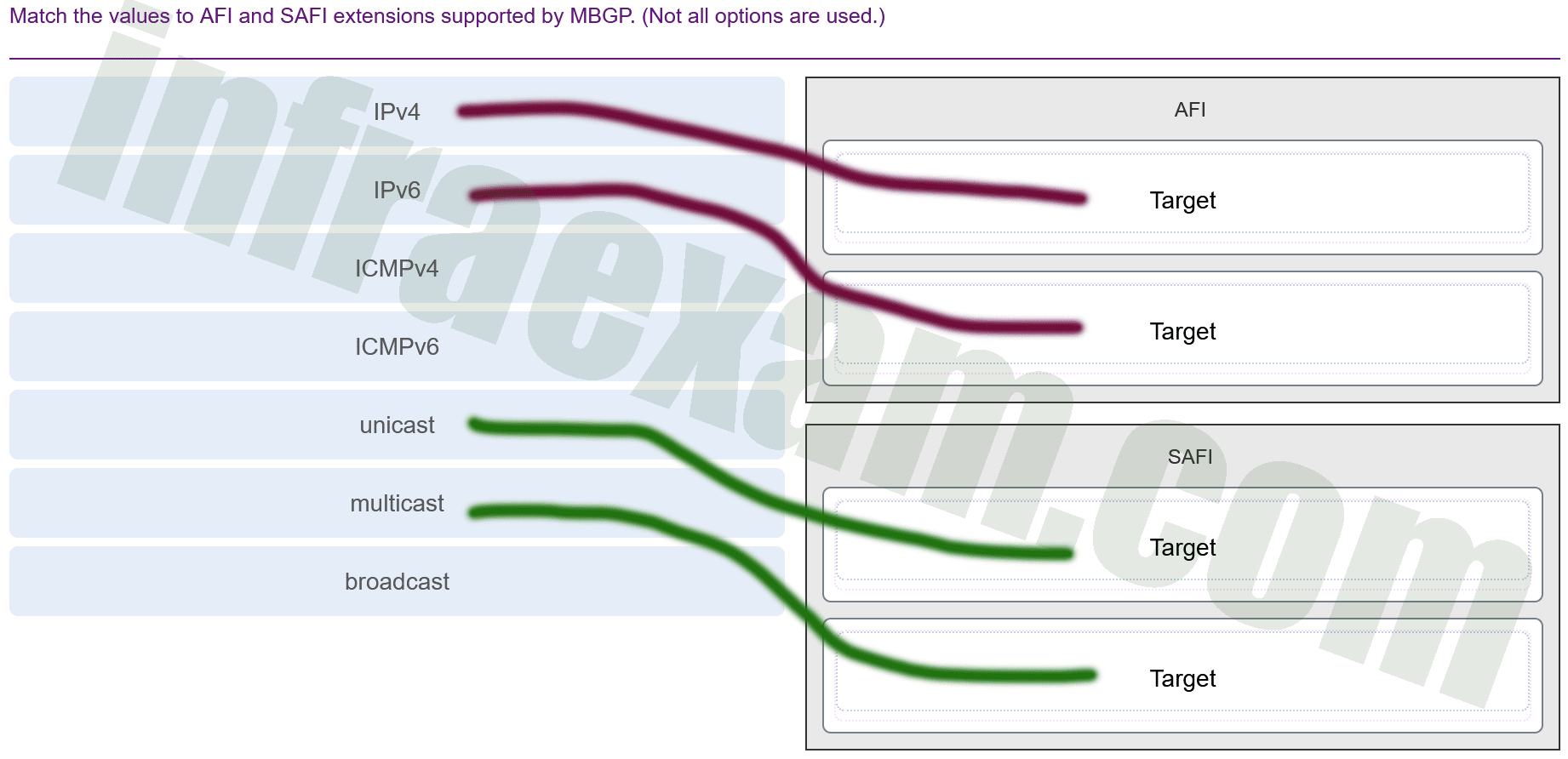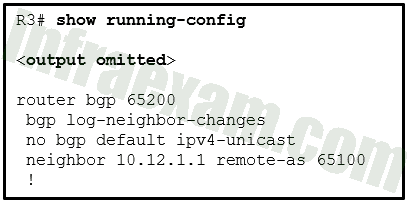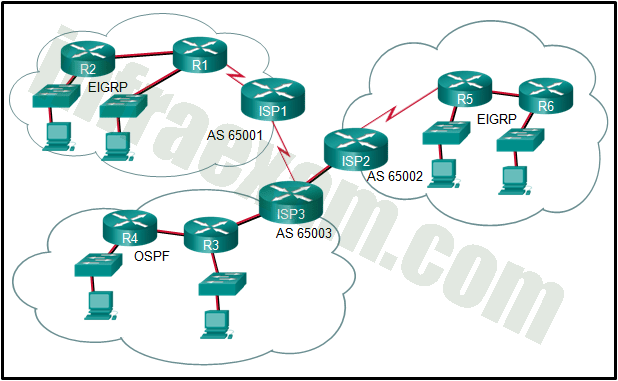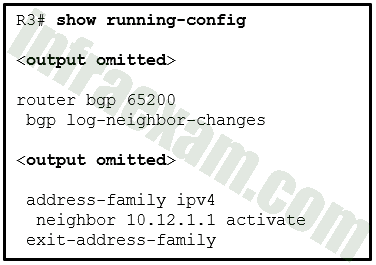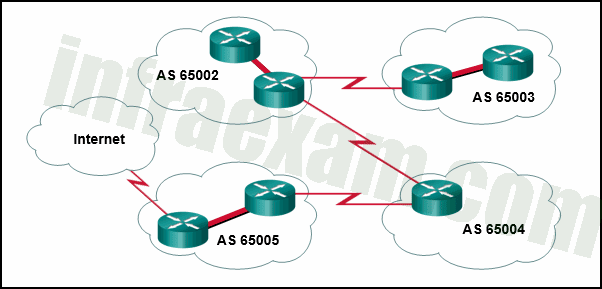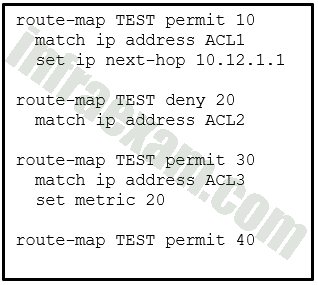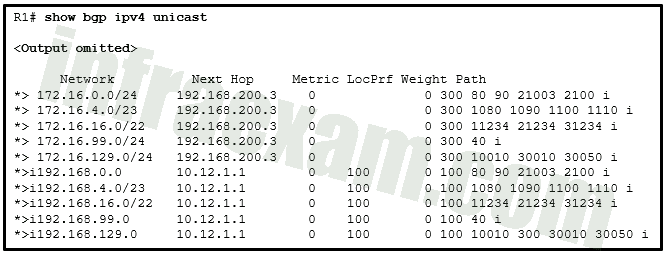CCNPv8 ENCOR (Version 8.0) – Chapters 11 – 12: BGP Exam Answers Full 100% 2024
CCNPv8 ENCOR (Version 8.0) – Chapters 11 – 12: BGP Exam Answers Full 100% 2024
| CCNP ENCOR v8 & 8.01 | |
| Final Exam Answers | |
| This Chapters 11 - 12 | |
| Chapters 11 - 12 Exam Answers | Online Test |
| Chapters 11 - 12 Quizzes Answers | Online Test |
| Next Chapters 13 - 14 | |
| Chapters 13 - 14 Exam Answers | Online Test |
| Chapters 13 - 14 Quizzes Answers | Online Test |
-
What TCP port is used by BGP to exchange messages between routers?
- 22
- 58
- 179
- 443
Answers Explanation & Hints: BGP routers exchange messages reliably over TCP using port 179.
-
Refer to the exhibit. Autonomous system 65500 is routing traffic between two external BGP autonomous systems, autonomous system 65200 and autonomous system 65100. Synchronization is disabled on BGP in autonomous system 65500. Which routers should have IBGP peer relationships for routing between autonomous system 65200 and autonomous system 65100 to work properly?
CCNPv8 ENCOR (Version 8.0) – Chapters 11 – 12 BGP Exam Answers 04 - R1 and R5
- R1, R3, and R4
- R1, R3, R4, and R5
- ISPA, R1, R5, and ISPB
Answers Explanation & Hints: Within the BGP AS 65500, because synchronization is disabled within the AS, IBGP should be used to establish peer relationships to provide routing service within the AS. R2 and R6 represent subnetworks. Static route and default route configuration provide adequate network access.
-
What type of BGP message precedes the successful formation of a BGP peering session?
- update
- keepalive
- established
- withdraw
- open
Answers Explanation & Hints: A BGP open message is used to establish a BGP adjacency. Both peer sides negotiate session capabilities before BGP peering is established.
-
Match the values to AFI and SAFI extensions supported by MBGP. (Not all options are used.)
CCNPv8 ENCOR (Version 8.0) – Chapters 11 – 12 BGP Exam Answers 001 Answers Explanation & Hints: -
To expand the support for multiple network layer protocols to original BGP-4, RFC 2858 added Multiprotocol BGP (MBGP/MP-BGP) capability by adding an extension called the address family identifier (AFI). An address family correlates to a specific network protocol, such as IPv4 or IPv6, and additional granularity is provided through a subsequent address family identifier (SAFI) such as unicast or multicast.
-
-
What is the order in determining the BGP router ID?
- statically defined, the highest IP address of any active interfaces, and the highest IP address of any active loopback interfaces
- the highest IP address of any active loopback interfaces, statically defined, and the highest IP address of any active interfaces
- statically defined, the highest IP address of any active loopback interfaces, and the highest IP address of any active interfaces
- the highest IP address of any active interfaces, statically defined, and the highest IP address of any active loopback interfaces
Answers Explanation & Hints: For a BGP session to initiate, one address family for a neighbor must be activated. On Cisco routers the IPv4 address family is activated by default; however, it may cause confusion when working with other address families. The BGP router configuration command no bgp default ip4-unicast disables the automatic activation of the IPv4 AFI.
-
Refer to the exhibit. A network administrator is configuring BGP on a router. Which configuration step is needed in order to establish the BGP session with the neighbor router?
CCNPv8 ENCOR (Version 8.0) – Chapters 11 – 12 BGP Exam Answers 06 - Restart the BGP process.
- Configure the keepalive timer.
- Initialize and activate the address family.
- Advertise the networks attached to the router.
Answers Explanation & Hints: For a BGP session to initiate, one address family for a neighbor must be activated. On Cisco routers the IPv4 address family is activated by default; however, it may cause confusion when working with other address families. The BGP router configuration command no bgp default ip4-unicast disables the automatic activation of the IPv4 AFI.
-
Refer to the exhibit. A network administrator issues the show bgp ipv4 unicast command to check the routes in the BGP table. What does the indication of 0.0.0.0 under Next Hop mean?
CCNPv8 ENCOR (Version 8.0) – Chapters 11 – 12 BGP Exam Answers 08 - The route is learned through IGP.
- The route is learned through a static route.
- The route is the best route for the network prefix.
- The route is originated from a connected network to the router.
Answers Explanation & Hints: As the BGP prefix is installed into the Loc-RIB table, the following BGP PAs are set, depending on the RIB prefix type:
Connected network : The next-hop BGP attribute is set to 0.0.0.0, the BGP origin attribute is set to i (IGP), and the BGP weight is set to 32,768.
Static route or routing protocol : The next-hop BGP attribute is set to the next-hop IP address in the RIB, the BGP origin attribute is set to i (IGP), the BGP weight is set to 32,768, and the MED is set to the IGP metric.
-
Refer to the exhibit. Which two configurations will allow router R1 to establish a neighbor relationship with router R2? (Choose two.)
CCNPv8 ENCOR (Version 8.0) – Chapters 11 – 12 BGP Exam Answers 02 - R1(config)# router bgp 65001
R1(config-router)# network 192.168.20.0 - R1(config)# router bgp 65001
R1(config-router)# network 192.168.10.0
R1(config-router)# neighbor 209.165.200.226 remote-as 65002 - R1(config)# router bgp 65002
R1(config-router)# network 192.168.20.0
R1(config-router)# neighbor 209.165.200.225 remote-as 65001 - R2(config)# router bgp 65002
R2(config-router)# network 192.168.10.0 - R2(config)# router bgp 65002
R2(config-router)# network 192.168.10.0
R2(config-router)# neighbor 209.165.200.226 remote-as 65002 - R2(config)# router bgp 65002
R2(config-router)# network 192.168.20.0
R2(config-router)# neighbor 209.165.200.225 remote-as 65001Answers Explanation & Hints: To configure EBGP, the router bgp command is followed by the AS number in which the router resides. Conversely, the neighbor command contains the AS number to which the remote router belongs.
- R1(config)# router bgp 65001
-
Which BGP routers will become peers and share routing information?
- BGP routers that are configured with the same network command
- BGP routers that share routing information with all routers in the same AS by default
- BGP routers that are configured with the neighbor command
- BGP routers that are configured with the same peer command
Answers Explanation & Hints: In BGP configuration, the BGP router configuration command neighbor ip-address remote-as as-number is used to identify the IP address and autonomous system number associated with the BGP neighbor.
-
Refer to the exhibit. Given the above configuration commands, which two statements are true? (Choose two.)
CCNPv8 ENCOR (Version 8.0) – Chapters 11 – 12 BGP Exam Answers 05 - RTA will send the supernet route and suppress the more specific routes known to BGP.
- RTA will send the supernet route as well as all other specific BGP routes that belong to that supernet.
- RTA will create the supernet route even if no other specific routes belonging to the supernet are in the route table.
- RTA will set the atomic aggregate attribute to true.
- RTA will set the atomic aggregate attribute to false.
Answers Explanation & Hints: Route summarization on BGP edge routers via dynamic method is configured by specifying an aggregation network prefix. The aggregate-address command advertises the aggregated route (the supernet) in addition to the specific original component network prefixes. By using the optional summary-only keyword, the component network prefixes in the summarized network range are suppressed. When a BGP router summarizes a route, it does not advertise the AS_Path information from before the aggregation. This effect is indicated by the atomic aggregate attribute. The atomic aggregate attribute indicates that a loss of path information has occurred.
-
A network administrator is configuring route summarization for received routes before advertising to the next peer with the commands:
R1(config)# router bgp 65500 R1(config-router)# aggregate-address 172.16.0.0 255.255.240.0 as-set summary-only R1(config-router)# end
How will the aggregate route be advertised after the commands are entered?
- The aggregate route will be advertised as an atomic aggregate route.
- The aggregate route will be advertised with previous BGP path information.
- The aggregate route will be advertised together with the smaller component network prefixes.
- The advertised aggregate route will increase the hop counts as it indicates multiple autonomous systems.
Answers Explanation & Hints: Route summarization on BGP edge routers via dynamic method is configured by specifying an aggregation network prefix. The aggregate-address command advertises the aggregated route in addition to the specific original component network prefixes. By using the optional summary-only keyword, the component network prefixes in the summarized network range are suppressed. When a BGP router summarizes a route, it does not advertise the AS_Path information from before the aggregation. This is indicated by the atomic aggregate attribute. To keep the BGP path information history, the optional as-set keyword may be used with the aggregate-address command. The AS_Path settings from the original prefixes are stored in the AS_SET portion of the AS_Path. The AS_SET, which is displayed within brackets, only counts as one hop, even if multiple autonomous systems are listed.
-
Which two statements describe the configuration differences when MP-BGP is applied using the IPv6 protocol compared to IPv4 protocol? (Choose two.)
- IPv6 uses multicast to establish neighbor sessions.
- IPv4 addresses cannot be used to define a BGP RID.
- Routers with only IPv6 addressing must have the BGP RID statically defined.
- Routers with only IPv6 addressing must use AS numbers beyond 65535.
- The IPv6 address family must be initialized and the neighbor activated.
Answers Explanation & Hints: The BGP configuration rules in IPv4 apply to IPv6, except that the IPv6 address family must be initialized, and the neighbor is activated. Routers with only IPv6 addressing must statically define the BGP RID to allow sessions to form.
-
A network administrator is configuring IPv6 route summarization on a BGP router. The objective is to aggregate the IPv6 networks from 2001:db8:0:0::/64 to 2001:db8:0:35::/64 into a single summary route. Which aggregation command should be used for the task?
- aggregate-address 2001:db8::/60 summary-only
- aggregate-address 2001:db8::/61 summary-only
- aggregate-address 2001:db8::/58 summary-only
- aggregate-address 2001:db8::/59 summary-only
Answers Explanation & Hints: The fourth hexadecimal of the IPv6 network 2001:db8:0:35::/64 is 0x35 that is equivalent to binary notation of 00110101. Thus 6 bits is the least needed for the purpose of route summarization.
-
Refer to the exhibit. What is used to exchange routing information between routers within each AS?
CCNPv8 ENCOR (Version 8.0) – Chapters 11 – 12 BGP Exam Answers 01 - static routing
- IGP routing protocols
- EGP routing protocols
- default routing
Answers Explanation & Hints: IGP routing protocols such as EIGRP and OSPF are used within an organization to exchange routes. An EGP routing protocol such as BGP is used to route traffic originating within one AS to the rest of the Internet (other individual autonomous systems).
-
Refer to the exhibit. A network administrator is configuring BGP on a router. What network layer protocol and function are enabled for the BGP session?
CCNPv8 ENCOR (Version 8.0) – Chapters 11 – 12 BGP Exam Answers 07 - IPv4 protocol with all the functions.
- IPv4 protocol with TCP connections.
- IPv4 protocol with unicast communication.
- IPv4 protocol with both unicast and multicast communications.
Answers Explanation & Hints: The address family is initialized by using the BGP router configuration command address-family afi safi . On IOS and IOS XE devices, the default subsequent address family identifier (SAFI) for the IPv4 and IPv6 address families is unicast and is optional.
-
Which BGP state is the one where an Open message has been sent from the originating router and is awaiting an Open message from the other router?
- Passive
- ExStart
- 2-way
- OpenSent
-
Explanation & Hint: The BGP (Border Gateway Protocol) state where an Open message has been sent from the originating router and is awaiting an Open message from the other router is OpenSent. In this state, the router has sent an Open message, which initiates the peering session, and is waiting for an Open message in response from the peer to proceed with the BGP session establishment.
-
Which BGP message is sent when an error is detected with the BGP session causing the BGP connection to close?
- Reply
- Query
- Database description
- Notification
-
Explanation & Hint: When an error is detected with the BGP (Border Gateway Protocol) session causing the BGP connection to close, a Notification message is sent. The Notification message is used to inform the other side of the session about the error that has occurred, leading to the termination of the BGP session.
-
Which BGP message is sent when an error is detected with the BGP session causing the BGP connection to close?
- Query
- Request
- Reply
- Notification
-
Explanation & Hint: When an error is detected with the BGP (Border Gateway Protocol) session causing the BGP connection to close, a Notification message is sent. The Notification message serves the purpose of indicating that a specific error has been detected, which leads to the termination of the BGP session.
-
Which BGP state is the one where BGP waits for a KEEPALIVE or NOTIFICATION message from a neighbor so that the BGP session can be moved to Established?
- Init
- Attempt
- Down
- OpenConfirm
-
Explanation & Hint: The BGP state where BGP waits for a KEEPALIVE or NOTIFICATION message from a neighbor so that the BGP session can be moved to Established is OpenConfirm. In the OpenConfirm state, the router has received an Open message from its peer and has sent back a KEEPALIVE message. It now awaits a KEEPALIVE or NOTIFICATION message in response. If a KEEPALIVE message is received, the state transitions to Established. If a NOTIFICATION message is received, the session is terminated due to an error.
-
Which BGP state is the one where BGP waits for a KEEPALIVE or NOTIFICATION message from a neighbor so that the BGP session can be moved to Established?
- Idle
- Connect
- OpenSent
- OpenConfirm
-
Explanation & Hint: The BGP state where BGP waits for a KEEPALIVE or NOTIFICATION message from a neighbor so that the BGP session can be moved to Established is OpenConfirm. In the OpenConfirm state, the router has successfully exchanged Open messages with its neighbor, establishing the basic parameters of the BGP session, and is now waiting for a KEEPALIVE or NOTIFICATION message to confirm the session should be maintained or terminated.
-
Which BGP attribute includes a complete list of all the ASNs that the prefix advertisement has traversed from its source AS?
- Next Hop
- Multiple-exit discriminator (MED)
- Local Preference (LocPrf)
- AS_Path
-
Explanation & Hint: The BGP attribute that includes a complete list of all the Autonomous System Numbers (ASNs) that the prefix advertisement has traversed from its source AS is AS_Path. This attribute is crucial for loop prevention and path selection in BGP routing.
-
Which BGP attribute includes a complete list of all the ASNs that the prefix advertisement has traversed from its source AS?
- Local Preference (LocPrf)
- Multiple-exit discriminator (MED)
- Weight
- AS_Path
-
Explanation & Hint: The BGP attribute that includes a complete list of all the Autonomous System Numbers (ASNs) that the prefix advertisement has traversed from its source AS is AS_Path. This attribute is essential for loop prevention and helps in the path selection process by allowing BGP routers to make decisions based on the path advertisements have taken through different ASes.
-
Which BGP state is the one where BGP initiates the TCP connection and sends an Open message to the sender?
- Passive
- Established
- OpenSent
- Connect
-
Explanation & Hint: The Connect state in BGP (Border Gateway Protocol) is a bit earlier in the process of establishing a BGP session than the OpenSent state. In the Connect state, the router is attempting to establish a TCP connection with its BGP peer. If the TCP connection attempt is successful, the BGP state machine moves to the OpenSent state, where the router sends an Open message to the BGP peer to initiate the BGP session.
Here’s a simplified sequence of the BGP states leading to a session establishment:
- Idle: The initial state where BGP waits to start the peering process.
- Connect: The router is attempting to establish a TCP connection with the peer. If successful, it moves to OpenSent; if unsuccessful, it may retry the connection attempt or fall back to the Idle state.
- OpenSent: Once the TCP connection is established, the router sends an Open message to the peer, moving the process to the next stage.
So, while the OpenSent state is where the Open message is sent following a successful TCP connection, the Connect state is specifically focused on establishing that TCP connection itself before any BGP messages are exchanged.
-
Which BGP attribute is used as a loop-prevention mechanism in BGP?
- Multiple-exit discriminator (MED)
- Local Preference (LocPrf)
- Next Hop
- AS_Path
-
Explanation & Hint: The BGP attribute used as a loop-prevention mechanism in BGP is AS_Path. This attribute lists all the Autonomous Systems (AS) that an advertisement has passed through to reach a destination. By inspecting the AS_Path, BGP can detect and prevent routing loops by rejecting routes that include its own AS number in the path.
-
Which BGP attribute is used as a loop-prevention mechanism in BGP?
- Multiple-exit discriminator (MED)
- Local Preference (LocPrf)
- Origin
- AS_Path
-
Explanation & Hint: The BGP attribute used as a loop-prevention mechanism in BGP is AS_Path. This attribute records the sequence of Autonomous Systems (AS) that an advertisement has traversed. By examining the AS_Path, a BGP router can detect and prevent routing loops by refusing to accept routes that contain its own AS number in the path.
-
Refer to the exhibit. For which autonomous system would running BGP not be appropriate?
CCNPv8 ENCOR (Version 8.0) – Chapters 11 – 12 BGP Exam Answers 03 - 65002
- 65003
- 65004
- 65005
Answers Explanation & Hints: It is appropriate to use BGP when an autonomous system is multihomed, or has more than one connection to another autonomous system or to the Internet. BGP is not appropriate for single-homed autonomous systems. Autonomous system 65003 is a single-homed AS because it is only connected to one other autonomous system, 65002.
-
A company is deploying BGP multihoming to provide internet connection redundancy. Which method can be used to avoid the internet transit routing situation?
- deploying iBGP routing in all routers within the local AS
- ensuring that no IGP session is running on the local BGP routers
- designating a data center or a specific location to handle the internet transit traffic
- applying outbound BGP route policies that only allow for local BGP routes to be advertised
Answers Explanation & Hints: If an enterprise uses BGP to connect with more than one service provider, it runs the risk of its autonomous system (AS) becoming a transit AS. Because BGP uses path cost to select best path, a path through the internal BGP routers might appear with a better path cost, hence the risk of local AS providing transit routing to everyone in the internet. Transit routing can be avoided by applying outbound BGP route policies that only allow for local BGP routes to be advertised to other autonomous systems.
-
Refer to the exhibit. Which statement describes the condition when the BGP route-map TEST permit 40 command is processed and what is the result of processing?
CCNPv8 ENCOR (Version 8.0) – Chapters 11 – 12 BGP Exam Answers 11 - Only networks that do not match ACL3 will match and be allowed.
- Incoming networks that match ACL1, ACL2, and ACL3 will match and be allowed.
- All incoming networks that do not match ACL1, ACL2, and ACL3 will match and be allowed.
- All incoming networks that do not match ACL1, ACL2, and ACL3 will match, but will be dropped because no action is specified.
Answers Explanation & Hints: A route map uses the command syntax route-map route-map-name [ permit | deny ] [ sequence-number ]. The rules that apply to route map statements are as follows:
If a processing action is not provided, the default value permit is used.
If a sequence number is not provided, the sequence number is incremented by 10 automatically.
If a matching statement is not included, an implied all prefixes is associated with the statement.
Processing within a route map stops after all optional actions have processed and after matching a conditional matching criterion.
-
A company is deploying BGP multihoming to provide network connection redundancy for several branch locations. One of the network design objectives is to provide deterministic routing among company locations during failover by providing a specific location to handle branch transit traffic. Which two design criteria should be applied to the specific facility? (Choose two.)
- OSPF is the preferred IGP for the facility.
- The routing pattern is bidirectional and predictable.
- The bandwidth can be sized according to the traffic needs.
- The facility should be in a central place from all company locations.
- BGP route policies should apply to only allow for local BGP routes to be advertised.
Answers Explanation & Hints: Multihomed environments should be configured so that branch routers cannot act as transit routers. In most designs, transit routing of traffic from another branch is undesirable, as WAN bandwidth may not be sized accordingly. If transit behavior is required, it should be restricted to the data centers or specific locations with these design criteria:
Proper routing design can accommodate outages.
Bandwidth can be sized accordingly.
The routing pattern is bidirectional and predictable.
-
A network administrator is configuring a prefix list with the ip prefix-list command. What is the best practice in dealing with the sequence number in creating a prefix list?
- Sequence numbers should start with 1.
- Sequence numbers should be incremented by 2.
- Sequence numbers should be no higher than 100.
- Sequence numbers should leave enough space to accommodate additional entries.
Answers Explanation & Hints: Prefix lists are configured with the global configuration command ip prefix-list prefix-listname [ seq sequence-number ] { permit | deny } high-order-bit-pattern / high-order-bit-count [ ge ge-value ] [ le le-value ]. Because prefix lists cannot be re-sequenced, it is advisable to leave enough space for insertion of sequence numbers at a later time.
-
A network administrator is configuring a prefix list with the command
ipv6 prefix-list IPV6-1 seq 5 permit 2001:db8:abcd:30::/60 ge 61 le 63
Which two networks match the prefix match specification? (Choose two.)
- 2001:db8:abcd:30::/60
- 2001:db8:abcd:34::/62
- 2001:db8:abcd:20::/62
- 2001:db8:abcd:36::/63
- 2001:db8:abcd:60::/64
Answers Explanation & Hints: The prefix matching logic works the same for IPv6 networks as for IPv4 networks. The fourth hexadecimal group of the match specification is 0x0030, which is 00000000 00110000 in binary. To match /60 prefix length, the fourth hexadecimal group of a network must be between 00000000 00110000 and 00000000 00111111, that is, between 0x0030 and 0x003F. The prefix length must be between /61 and /63.
-
Match the route map component to the description. (Not all options are used.)
CCNPv8 ENCOR (Version 8.0) – Chapters 11 – 12 BGP Exam Answers 002 Answers Explanation & Hints: A route map has four components:
- Sequence number: Dictates the processing order of the route map.
- Conditional matching criteria: Identifies prefix characteristics (network, BGP path attribute, next hop, and so on) for a specific sequence.
- Processing action: Permits or denies the prefix.
- Optional action: Allows for manipulations, depending on how the route map is referenced on the router. Actions can include modification, addition, or removal of route characteristics.
-
Refer to the exhibit. Considering the route map configuration for BGP, which statement describes the condition for a network prefix to match the route map TEST ?
CCNPv8 ENCOR (Version 8.0) – Chapters 11 – 12 BGP Exam Answers 12 - If the processing action is deny, the network prefix needs to match both ACL1 and ACL2.
- If the processing action is permit, the network prefix needs to match either ACL1 or ACL2.
- The network prefix needs to match either ACL1 or ACL2 independently of the processing action.
- The network prefix needs to match both ACL1 and ACL2 independently of the processing action.
Answers Explanation & Hints: In route map configuration, if there are multiple variables (ACLs, prefix lists, tags, and so on) configured for a specific route map sequence, only one variable must match for the prefix to qualify. The Boolean logic uses an OR operator for this configuration. The processing action is performed only after a match occurs.
-
Refer to the exhibit. A network administrator is configuring BGP route filtering on R1. The objective is to advertise only locally originated routes to its neighbor to avoid undesirable transit connectivity. Which AS path ACL should the administrator configure?
CCNPv8 ENCOR (Version 8.0) – Chapters 11 – 12 BGP Exam Answers 13 - ip as-path access-list 1 permit *$
- ip as-path access-list 1 permit ^$
- ip as-path access-list 1 permit _$
- ip as-path access-list 1 permit [^$]
Answers Explanation & Hints: To restrict traffic to only locally originated traffic, configure the AS path ACL using the regex pattern ^$.
-
Which two statements describe private BGP communities? (Choose two.)
- A private BGP community requires a route map configuration.
- An organization needs to register for a private BGP community.
- Private BGP communities are used to signify no transit networks.
- Private BGP communities are within the range of 0xFFFF0000 to 0xFFFFFFFF.
- A private BGP community uses the first 16 bits to represent its AS and the second 16 bits to represent a pattern.
Answers Explanation & Hints: Private BGP communities follow a convention where the first 16 bits represent the AS of the community organization, and the second 16 bits represent a pattern defined by the originating AS. A private BGP community pattern can vary from organization to organization, does not need to be registered, and can signify geographic locations for one AS while signifying a method of route advertisement in another AS. A private BGP community is set in a route map with the command set community bgpcommunity [ additive ].
-
Which three statements describe the weight attribute for BGP? (Choose three.)
- It is a Cisco-defined attribute.
- It is not advertised to other routers.
- It is a 16-bit value assigned locally on the router.
- It is a nontransitive attribute that uses a 32-bit value called metric.
- It is a well-known discretionary path attribute and is included with path advertisements throughout an AS.
- It is not advertised between eBGP peers and is typically used to influence the next-hop address for outbound traffic.
Answers Explanation & Hints: BGP weight is a Cisco-defined attribute and the first step for selecting the BGP best path. Weight is a 16-bit value (0 to 65,535) assigned locally on the router; it is not advertised to other routers.
-
Which BGP attribute can be configured on IBGP speakers so they will choose a desired path out of the autonomous system to an outside network?
- MED
- next hop
- aggregate
- local preference
Answers Explanation & Hints: The local preference attribute indicates the preference for exiting the AS to the destination network. The local preference is not advertised between eBGP peers and is typically used to influence the next-hop address for outbound traffic (that is, leaving an autonomous system). Local preference can be set for specific routes by using a route map or for all routes received from a specific neighbor. A higher value is preferred over a lower value.
-
A network administrator is configuring an ACL to match networks for BGP route filtering. The administrator creates an ACE permit ip 10.0.64.0 0.0.63.0 255.255.255.0 0.0.0.192 . Which two networks match the ACE? (Choose two.)
- 10.0.64.0/24
- 10.0.63.0/26
- 10.0.126.0/25
- 10.0.130.0/24
- 10.0.128.0/25
Answers Explanation & Hints: One method for conditional matching of routes in BGP is through extended ACLs. When extended ACLs are used for this purpose, the source fields match against the network portion of the route, and the destination fields match against the network mask. The network portion of the matching networks is 10.0.64.0 through 10.0.127.0. The network mask portion is /24 through /26.
-
A network administrator is configuring a prefix list to match networks for BGP route filtering. Which two networks match the prefix match specification 10.224.0.0/12 ge 24 le 28 ? (Choose two.)
- 10.224.10.0/12
- 10.240.10.0/24
- 10.230.15.0/24
- 10.192.20.0/26
- 10.239.255.240/28
Answers Explanation & Hints: Prefix lists provide another method of identifying networks in a routing protocol. A prefix list identifies a specific IP address, network, or network range and allows for the selection of multiple networks with a variety of prefix lengths by using a prefix match specification. A prefix match specification contains two parts: a high-order bit pattern and a high-order bit count, which determines the high-order bits in the bit pattern that are to be matched. The high-order bit pattern is also known as the network address and the high-order bit count as the mask length. The network portion of the matching networks is 10.224.0.0 and higher. The mask length of the matching networks must be greater than or equal to /24 and less than or equal to /28.
-
Refer to the exhibit. A network administrator is troubleshooting BGP configuration and wants to display only routes that originated in AS 40. Which regular expression should the administrator use in the command show bgp ipv4 unicast regex regex-pattern ?
CCNPv8 ENCOR (Version 8.0) – Chapters 11 – 12 BGP Exam Answers 10 - show bgp ipv4 unicast regex .40.
- show bgp ipv4 unicast regex _40$
- show bgp ipv4 unicast regex *40_
- show bgp ipv4 unicast regex ^40_
Answers Explanation & Hints: In troubleshooting BGP, regular expressions (regex) can be used to parse through the large number of available ASNs. Regular expressions are based on query modifiers used to select the appropriate content. The regex pattern _40$ indicates to only include the lines that originated in AS 40 (the last AS in the AS-Path). Some regex query modifiers are as follows:
_ (underscore) – matches a space
^ (caret) – indicates the start of a string
$ (dollar sign) – indicates the end of a string
. (period) – matches a single character, including a space
* (asterisk) – matches zero or more characters or patterns
-
Refer to the exhibit. A network administrator is troubleshooting BGP configuration and wants to display only routes with AS 300 being the first AS in the AS_Path value. Which regular expression should the administrator use in the command show bgp ipv4 unicast regex regex-pattern ?
CCNPv8 ENCOR (Version 8.0) – Chapters 11 – 12 BGP Exam Answers 09 - show bgp ipv4 unicast regex .300.
- show bgp ipv4 unicast regex $300
- show bgp ipv4 unicast regex _300_
- show bgp ipv4 unicast regex ^300_
Answers Explanation & Hints: In troubleshooting BGP, Regular expressions (regex) can be used to parse through the large number of available ASNs. Regular expressions are based on query modifiers used to select the appropriate content. The regex pattern ^300_ indicates to only include the lines that list the exact phrase of 300 as the first AS. Some regex query modifiers are as follows:
_ (underscore) – matches a space
^ (caret) – indicates the start of a string
$ (dollar sign) – indicates the end of a string
. (period) – matches a single character, including a space
| CCNP ENCOR v8 & 8.01 | |
| Final Exam Answers | |
| This Chapters 11 - 12 | |
| Chapters 11 - 12 Exam Answers | Online Test |
| Chapters 11 - 12 Quizzes Answers | Online Test |
| Next Chapters 13 - 14 | |
| Chapters 13 - 14 Exam Answers | Online Test |
| Chapters 13 - 14 Quizzes Answers | Online Test |
